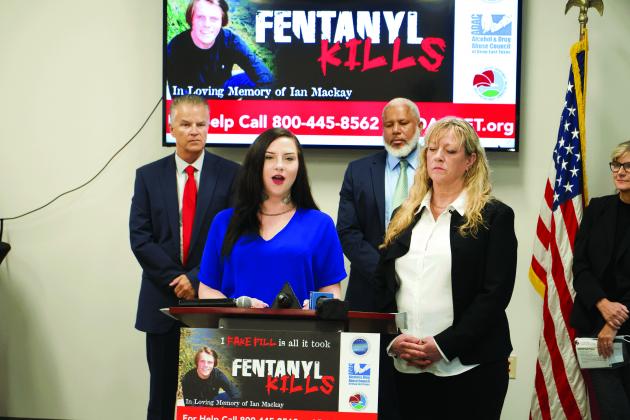Following a skyward trend in fentanyl-affiliated overdose deaths throughout the nation, local law enforcement officials – joined by an overdose survivor – held a May 24 meeting to announce they’re amping up efforts to educate potential victims and eradicate the issue altogether.
“Illegal fentanyl is a growing problem in our communities,” said Brit Featherston, acting U.S. Attorney for the Eastern District of Texas. “Although following and capturing overdose data is currently very difficult, what we are seeing indicates that overdose rates in the local area are, potentially, alarmingly high.”
Fentanyl is a synthetic chemical often used properly in a medical setting as a pain reliever. The kind of fentanyl that has been killing all manner of victims is often created in unregulated back alleys in foreign countries and added to illicit drugs like cocaine, heroin and methamphetamine, according to Featherston. Fentanyl is added to street drugs – such as Xanax, Adderall, Vicodin, hydrocodone, Percocet and oxycodone – in such a way that trained pharmacists can’t tell the difference by looking.
“From the two-year period encompassing 2020 and 2021, Beaumont emergency medical services ran approximately 1,000 ambulance runs, and private ambulance companies ran the same number of overdose calls for service,” Featherston estimated. “Getting a grasp on the size of the local problem is difficult, yet common sense tells us this is just way too high.”
Data compiled at the National Institute on Drug Abuse supports Featherston’s evaluation. In a report released in January, the institute found that 91,799 people died in the United States from overdoses in 2020. Of that number, approximately 60,000 were fentanyl-related deaths. The upward trajectory is made clear by 52,404 total overdose deaths reported in 2015 and fewer than 20,000 total reported in 2000.
In 2021, overdose fatalities from fentanyl outnumbered deaths from car accidents and shooting deaths combined, according to Featherston.
One pill can kill
After surviving at least 15 overdoses and nine trips to the hospital, Houston resident Chelsea Chanslor, 22, said she was addicted to drugs at 13, saying she never even considered getting clean for nearly a decade of use.
“I’m no one official. I don’t have a badge, I don’t have a job in this field. I’m just someone who has gone through addiction,” said Chanslor. “Of course, I didn’t start with IVs. I didn’t start where I ended up – that’s never the case.
“I woke up sometimes in my addiction feeling like the minute I picked up, I might as well have put a bullet in my head because you don’t see a way out of that lifestyle. You don’t see the light at the end of the tunnel.”
Chanslor said a very close friend named Cassandra was placed on a “One pill can kill” campaign sign outside the Dallas Cowboys stadium after she died from an overdose. Similar signs are planned for the Beaumont area, officials said.
“So, this campaign … it hits home,” Chanslor said. “It could have easily been my face.”
Victims dying from this dangerous substance aren’t stereotypical drug addicts, according to Featherston, who said, “They’re not alleyway addicts; they don’t have needles hanging out of their arms. These are college students, working people, who decided in a simple transgression to take a recreational drug on a Saturday night, usually taken without an adverse consequence, but in this situation it is killing them. Literally one pill can kill.
“On April 14, five West Point cadets overdosed on fentanyl-laced cocaine. On April 4, the University of Texas started making naloxone (Narcan) available to students for free, and naloxone is available in all dorms now due to increases in opioid overdoses. That oughta’ be a clue; it oughta’ be a wake-up call.”
‘It’s killing our children.’
Jefferson County Sheriff Zena Stephens said curbing fentanyl overdoses is a priority for her office. Suggesting its solution is two-pronged, Stephens offered, “The first thing that we need to do is educate the kids we come across in schools, kinda like the old D.A.R.E. program. It’s an issue with high school students, with college students, so it becomes very important that we educate people.
“The law enforcement piece is going to be very important. We are working those (narcotics) cases and making sure we identify folks who are making these synthetic drugs and putting them in the hands of our children.”
Stephens confirmed her office does have plans to send officers into local schools in an effort to educate students on fatal consequences that could befall them just by taking one pill.
“It’s so important for us to spread the information throughout the community and stop the overdoses,” she said. “It’s killing our children.”


